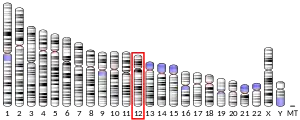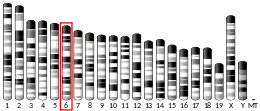Adipocyte Enhancer-Binding Protein is a zinc finger protein that in humans is encoded by the evolutionarily well-conserved gene AEBP2. It was initially identified due to its binding capability to the promoter[5] of the adipocyte P2 gene, and was therefore named Adipocyte Enhancer Binding Protein 2. AEBP2 is a potential targeting protein for the mammalian Polycomb Repression Complex 2 (PRC2).[6]
Function
AEBP2 is a DNA-binding transcriptional repressor. It may interact with and stimulate the activity of the PRC2 complex.[7]
AEBP2 may regulate the migration and development of the neural crest cells through the PRC2-mediated epigenetic mechanism and is most likely a targeting protein for the mammalian PRC2 complex.[8]
Clinical significance
Diseases associated with AEBP2 include Waardenburg's syndrome, and Hirschsprung's disease.[8]
References
- 1 2 3 GRCh38: Ensembl release 89: ENSG00000139154 - Ensembl, May 2017
- 1 2 3 GRCm38: Ensembl release 89: ENSMUSG00000030232 - Ensembl, May 2017
- ↑ "Human PubMed Reference:". National Center for Biotechnology Information, U.S. National Library of Medicine.
- ↑ "Mouse PubMed Reference:". National Center for Biotechnology Information, U.S. National Library of Medicine.
- ↑ Imhof, Axel; Kim, Hana; Bakshi, Arundhati; Kim, Joomyeong (2015). "Retrotransposon-Derived Promoter of Mammalian Aebp2". PLOS ONE. 10 (4): e0126966. Bibcode:2015PLoSO..1026966K. doi:10.1371/journal.pone.0126966. ISSN 1932-6203. PMC 4411029. PMID 25915901.
- ↑ Kim H, Kang K, Ekram MB, Roh TY, Kim J (2011). "Aebp2 as an epigenetic regulator for neural crest cells". PLOS ONE. 6 (9): e25174. Bibcode:2011PLoSO...625174K. doi:10.1371/journal.pone.0025174. PMID 21949878.
- ↑ Cao R, Zhang Y (July 2004). "SUZ12 is required for both the histone methyltransferase activity and the silencing function of the EED-EZH2 complex". Mol. Cell. 15 (1): 57–67. doi:10.1016/j.molcel.2004.06.020. PMID 15225548.
- 1 2 Kim H, Kang K, Kim J (2009). "AEBP2 as a potential targeting protein for Polycomb Repression Complex PRC2". Nucleic Acids Res. 37 (9): 2940–50. doi:10.1093/nar/gkp149. PMC 2685092. PMID 19293275.
External links
- Human AEBP2 genome location and AEBP2 gene details page in the UCSC Genome Browser.



